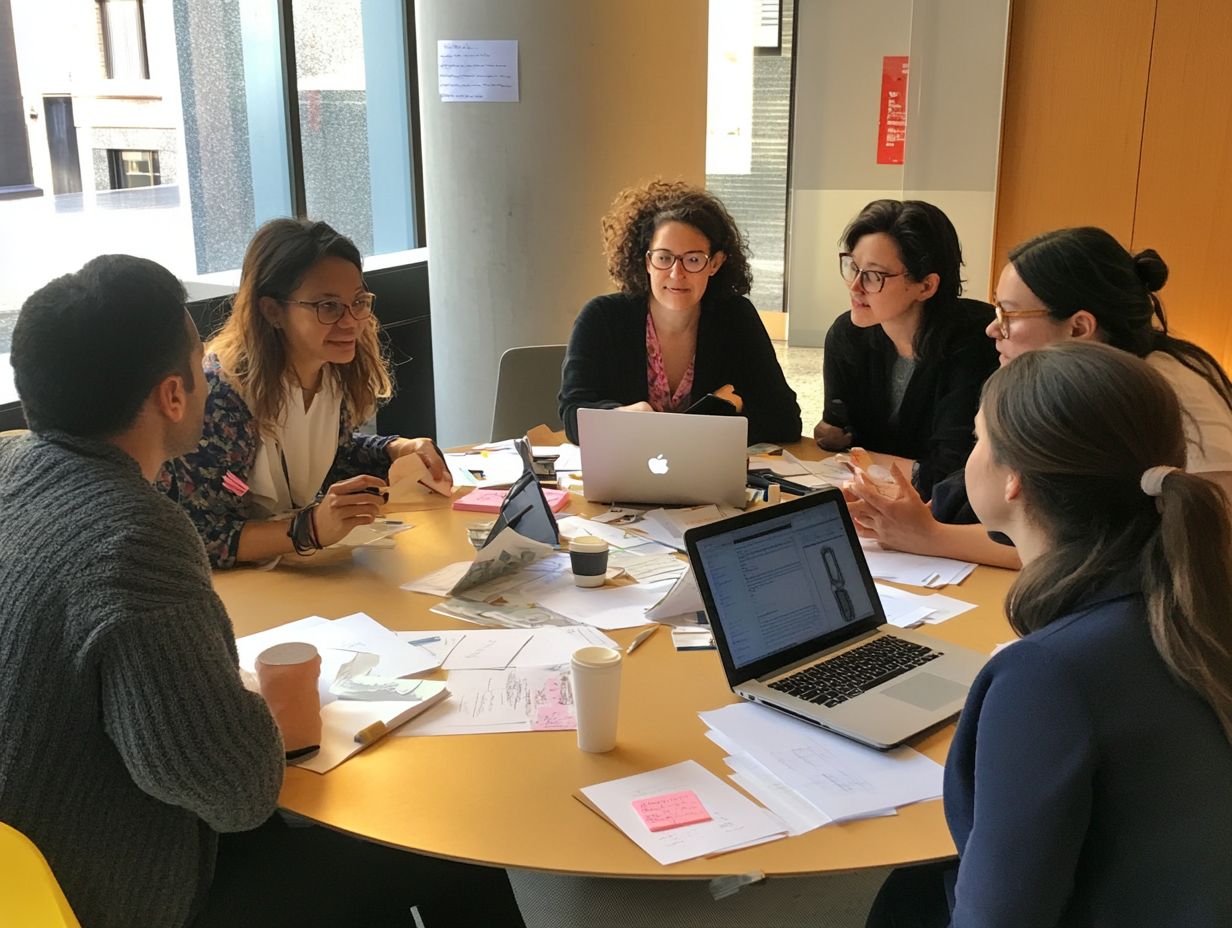Creating Inclusive Leadership Development Programs
In today s diverse workplace, embracing inclusive leadership has become essential for fostering innovation and enhancing performance.
This article delves into the significance of inclusive leadership and its transformative effect on organizational culture. You will explore the key components of effective leadership development programs, including how to tackle unconscious bias, improve communication, and nurture an inclusive environment.
Best practices for implementation and methods to evaluate the effectiveness of these initiatives will also be highlighted. Start now to transform your workplace into an inclusive and dynamic environment!
Contents
- Key Takeaways:
- The Importance of Inclusive Leadership
- Key Components of Inclusive Leadership Development Programs
- Implementing Inclusive Leadership Development Programs
- Best Practices and Strategies
- Evaluating the Effectiveness of Inclusive Leadership Development Programs
- Frequently Asked Questions
- What is the purpose of creating inclusive leadership development programs?
- Why is it important to have inclusive leadership development programs?
- What are the key elements of a successful inclusive leadership development program?
- How can inclusive leadership development programs benefit employees?
- Can inclusive leadership development programs help address issues of discrimination and bias in the workplace?
- How can organizations ensure the success of their inclusive leadership development programs?
Key Takeaways:

- Inclusive leadership is crucial for creating a diverse and thriving workplace.
- Addressing unconscious bias, promoting effective communication, and fostering a culture of inclusion are essential components of successful leadership development programs.
- Regular evaluation and improvement are necessary for the continued effectiveness of inclusive leadership development programs.
The Importance of Inclusive Leadership
Inclusive leadership transcends mere trend; it stands as an essential pillar of organizational success, cultivating a culture that genuinely values diverse perspectives.
In today s global marketplace, look to exemplary figures like Satya Nadella from Microsoft and Indra Nooyi from PepsiCo. Their approach rooted in empathy and respect for every team member demonstrates how such leadership can significantly enhance employee productivity and satisfaction.
By actively embracing diversity and inclusion, you can unlock the full potential of your diverse workforce, fostering an environment that thrives on innovation and agility.
Understanding the Impact of Inclusive Leadership
Inclusive leadership can transform your organization. It boosts employee satisfaction and sparks creative performance through an environment that champions continuous learning and a robust feedback culture.
This leadership approach cultivates a profound sense of belonging, giving you and your team members the power to share your unique perspectives, which ultimately sharpens problem-solving capabilities.
Consider companies like Google, which have effectively embraced inclusive practices; they’ve reported improvements in team performance by as much as 35%, illustrating how diverse teams generate innovative ideas and solutions.
Research from McKinsey shows that organizations with diverse leaders are 21% more likely to be profitable than those without. These statistics clearly illustrate that embracing diverse viewpoints not only enriches workplace culture but also enhances organizational agility, allowing you to adapt swiftly to market changes.
Key Components of Inclusive Leadership Development Programs
To cultivate inclusive leaders, your organization must concentrate on essential elements of inclusive leadership development programs. This entails integrating leadership training, diversity training, and effective communication strategies tailored to address the needs of marginalized groups, which refer to those groups that may not have equal access to opportunities. Creating a safe space for leadership growth is also crucial in this process.
By doing so, you can significantly enhance interactions between different cultural backgrounds and foster a more inclusive environment.
Identifying and Addressing Unconscious Bias

Identifying and addressing unconscious bias is a crucial step in cultivating Diversity, inclusion, and ethical leadership within your organization. These biases, often lurking beneath the surface, can infiltrate decision-making processes, subtly shaping outcomes in hiring, promotions, and team dynamics.
When you overlook these biases, your organization risks perpetuating inequities and stifling its potential for innovation and growth. Many organizations are now embracing comprehensive training programs designed to heighten awareness of these implicit prejudices. For example, companies like Google and Starbucks have launched initiatives to educate their teams about unconscious bias, encouraging engaging discussions and practical exercises.
By actively nurturing an inclusive environment through leadership development and policy changes, you not only enhance your workplace culture but also boost your organization s overall performance.
Effective Communication and Collaboration Strategies
Effective communication and collaboration strategies are crucial for you as an inclusive leader to foster team cooperation and boost employee productivity.
By employing techniques like active listening, you ensure that every team member feels heard and valued. Creating an environment where diverse perspectives are openly shared paves the way for richer discussions and innovative solutions.
Embracing technology and digital platforms can significantly enhance your efforts. Tools such as apps that help teams work together on projects and communication software not only facilitate real-time discussions but also archive conversations, ensuring transparency throughout the process. This integration supercharges engagement and empowers your employees to share their ideas, ultimately cultivating a more cohesive and motivated workforce.
Creating a Culture of Inclusion
Building an inclusive culture is a rewarding journey that requires dedication to nurturing inclusivity within the broader organizational framework while actively supporting employee resource groups.
You should encourage participation in these groups, as they serve as essential platforms for networking, mentorship, and advocacy. By offering flexible work environments, you can significantly enhance inclusivity, giving individuals the power to strike a healthy balance between their personal and professional responsibilities.
This level of adaptability fosters trust and sends a clear message that the organization genuinely values its workforce.
When employees feel appreciated and supported, they are far more likely to engage and contribute positively, resulting in heightened job satisfaction. Ultimately, cultivating a robust, inclusive culture is directly linked to greater retention rates, as individuals are naturally drawn to environments where they feel understood and empowered.
Implementing Inclusive Leadership Development Programs
Implementing inclusive leadership development programs requires a strategic approach that weaves leadership training seamlessly into your organizational framework. This integration not only enhances your organizational agility but also fosters a strong culture of feedback, empowering everyone to thrive and contribute effectively.
Start embracing inclusivity today!
Best Practices and Strategies

Adopting best practices and strategies for inclusive leadership is essential for your organization if you aim to harness diversity training for enhanced performance outcomes.
This means implementing comprehensive, ongoing training programs that not only educate you on the nuances of inclusivity but also equip you with tangible tools to cultivate an equitable workplace.
By emphasizing mentorship opportunities, you can enhance individual growth and foster a genuine sense of belonging among your team members.
Regular performance assessments are necessary to evaluate the effectiveness of these initiatives. This ensures inclusivity becomes a fundamental aspect of your organizational culture.
Evaluating the Effectiveness of Inclusive Leadership Development Programs
Start evaluating now to unlock the full potential of your inclusive leadership development programs! You must establish clear measures that assess performance outcomes and gauge employee satisfaction within your organization.
Measuring Impact and Making Improvements
Measuring the impact of inclusive leadership initiatives is crucial for you to make informed improvements that enhance workplace equity and foster a truly inclusive culture.
To effectively gauge how these programs resonate within your organization, you can employ a variety of strategies for collecting employee feedback.
Tools like surveys, focus groups, and regular check-ins become essential in this process, allowing your team members to express their experiences and perceptions.
Analyzing this data systematically not only uncovers areas of strength but also highlights opportunities for growth.
With these insights in hand, you can make informed adjustments to your inclusivity strategies, ensuring they better align with the needs and values of your workforce. This iterative approach supports ongoing development and cultivates an environment where everyone feels empowered to contribute.
Frequently Asked Questions
What is the purpose of creating inclusive leadership development programs?

The purpose of creating inclusive leadership development programs is to foster a diverse and inclusive workplace culture by equipping leaders with the necessary skills and knowledge to effectively lead and engage with diverse teams.
Why is it important to have inclusive leadership development programs?
Inclusive leadership development programs are important because they promote diversity, equity, and inclusion within an organization, leading to improved employee engagement, innovation, and overall business success. Discover how to create an inclusive skill enhancement program and explore how your organization can implement these practices today!
What are the key elements of a successful inclusive leadership development program?
The key elements of a successful inclusive leadership development program include a focus on developing self-awareness and understanding different cultures, providing opportunities for diverse perspectives and experiences, and incorporating inclusive practices and policies into leadership training.
How can inclusive leadership development programs benefit employees?
Inclusive leadership development programs can benefit employees by providing them with the necessary tools and resources to effectively navigate diverse and inclusive work environments. For organizations looking to enhance these initiatives, understanding how to develop leadership training programs can lead to improved job satisfaction, retention, and career advancement opportunities.
Can inclusive leadership development programs help address issues of discrimination and bias in the workplace?
Yes, inclusive leadership development programs can help address issues of discrimination and bias in the workplace by promoting awareness, understanding, and action towards creating a more inclusive and equitable workplace for all employees. Additionally, learning how to incorporate e-learning into leadership programs can enhance these efforts.
How can organizations ensure the success of their inclusive leadership development programs?
Organizations can ensure the success of their inclusive leadership programs by including diverse voices in creating and running the program, as highlighted in the role of gender in leadership development.
They should regularly evaluate feedback and provide ongoing support to participants. This approach fosters a culture of inclusion and growth.






